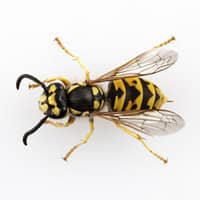You know it's spring when wasps start bumping against your eaves or zooming past your head like a heavy loaded cargo plane. This is especially noticeable if you have a balcony you enjoy, where you spend time near your roofline, or if you do a lot of work in your shed, where overhangs are at eye level. Whether or not you find yourself in a place where you notice wasp activity increasing in spring, it is important to know that it does. It is also important to know that spring is the best time of year to protect yourself from a painful summer, or fall, wasp incident. With stinging insects sending over 500,000 people to the emergency room each year, it makes sense to be proactive.
When it comes to building nests, wasps are pretty obvious about it--most of the time. You'll see them starting half umbrella looking gray nests as spring weather promises to stay. These nests can be found under overhangs, in the corners of canopies, under roof peaks, and in eaves and attic spaces. Buildings like sheds and outbuildings are particularly attractive to these insects.
If you find the fully formed egg-shaped nest of a Northern wasp, there is a good chance the nest is not populated. Wasp queens abandon their nests in fall to find a safe place to overwinter. They leave their workers to die. In spring, when they look for a new home, they never recolonize an old nest. They will, however, reuse a good nesting site and start building a home next to an old home. Be sure that the nest does not go up into the structure. If it does, there could be a much larger nest on the inside, and healthy wasps to protect it. This is particularly the case with yellow jackets that love building giant nests in the strangest of places, like old cars, furniture, and any structure that has been abandoned--no matter how small.
Most spring wasps and yellow jackets are starting a new home. This makes them more aggressive. When you make an inspection of your yard, eaves, overhangs, roof peaks and attic spaces, be sure to stay far away from these developing nests.
-
Wasps and yellow jackets do not lose their stinger. These insects can cling to your skin and sting you several times.
-
Wasps, but especially yellow jackets, will pursue you for great distances, even going around obstacles to get to you.
-
Both of these insects will swarm to protect their nests.
-
Some people are deathly allergic to the venom from wasps and yellow jackets. If you've never been stung by either of these insects, proceed with caution.
Contact a pest control company if you have spotted a nest around your home or property. When it comes to wasps and yellow jackets, it is always better to be safe than sorry.
 1426 Reviews
1426 Reviews


